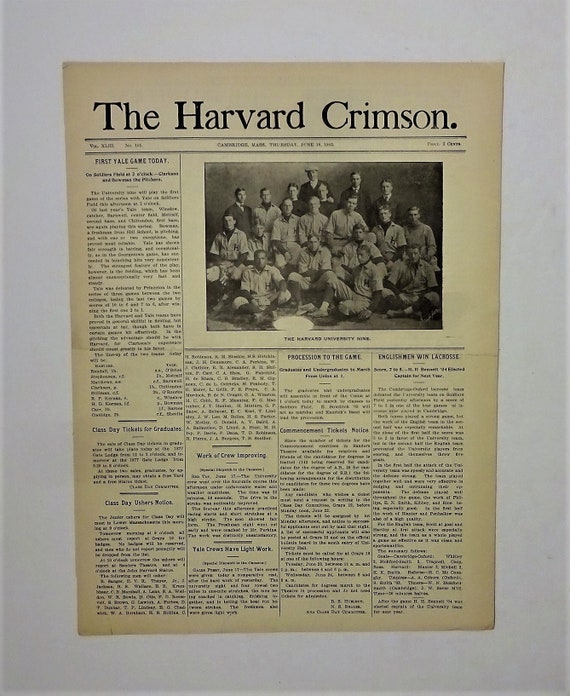Let’s talk about something iconic, something that’s been shaping the world of campus journalism for over a century—the Harvard Crimson Newspaper. It’s not just any college paper; it’s a powerhouse of student-led journalism that’s been influencing minds, sparking debates, and setting standards in the world of media. If you’ve ever wondered what makes this publication so special, buckle up because we’re diving deep into its rich history and legacy.
Imagine a world where students don’t just sit in classrooms but also step into the world of journalism, learning how to chase stories, write compelling articles, and edit with precision. That’s exactly what the Harvard Crimson has been doing since 1873. It’s more than just a newspaper; it’s a training ground for future journalists, editors, and thought leaders. And honestly, who wouldn’t want to be part of something this epic?
Now, before we get into the nitty-gritty details, let’s take a moment to appreciate the sheer impact this newspaper has had on journalism as a whole. From covering groundbreaking campus events to tackling national issues, the Harvard Crimson has consistently been at the forefront of campus journalism. So, whether you’re a journalism enthusiast, a history buff, or just curious about how student publications shape the world, you’re in the right place.
Read also:Dr Eric Berg Wikipedia The Ultimate Guide To His Life Work And Impact
The Origins of the Harvard Crimson: How It All Began
Every great story has a beginning, and the Harvard Crimson’s story is no different. Back in 1873, a group of ambitious students decided that the campus needed a voice—a platform where ideas could be shared, opinions could be expressed, and news could be reported. And just like that, the Harvard Crimson was born. It started as a small publication but quickly grew into a powerhouse of campus journalism.
Here’s the thing about the Harvard Crimson: it wasn’t just about reporting the news. It was about shaping the narrative. The students who founded it had a vision—to create a publication that wasn’t afraid to tackle tough topics, challenge the status quo, and give a voice to the voiceless. And that vision has been carried forward by every generation of Crimson editors and writers.
Key Milestones in the Crimson's History
Let’s talk milestones because the Harvard Crimson has had its fair share of them. From covering historic campus events to publishing articles that sparked national debates, the Crimson has been there, done that, and left its mark. Here are a few highlights:
- In 1926, the Crimson became the first daily student newspaper in the United States. Yeah, you read that right—daily. Talk about dedication!
- During the civil rights movement, the Crimson played a crucial role in amplifying voices that were often ignored. It wasn’t just reporting the news; it was shaping the conversation.
- In the digital age, the Crimson embraced technology, becoming one of the first student newspapers to have a strong online presence. This move helped it reach a wider audience and stay relevant in an ever-changing media landscape.
Understanding the Harvard Crimson's Role in Campus Journalism
Now that we’ve talked about the history, let’s dive into the present. What exactly does the Harvard Crimson do, and why is it so important? Simply put, it’s the heartbeat of campus journalism at Harvard. It covers everything from academic breakthroughs to campus controversies, ensuring that no stone is left unturned.
But it’s not just about reporting the news. The Crimson also serves as a training ground for aspiring journalists. Students who work for the paper learn the ins and outs of journalism, from writing and editing to photography and design. And let’s not forget the invaluable experience they gain by working in a fast-paced, deadline-driven environment.
How the Crimson Shapes Student Voices
One of the most fascinating aspects of the Harvard Crimson is how it empowers students to use their voices. Whether it’s through opinion pieces, investigative journalism, or creative writing, the Crimson gives students a platform to express themselves and make an impact. And in today’s world, where voices matter more than ever, that’s a pretty big deal.
Read also:Xhmaster The Ultimate Guide To Understanding And Mastering The Tool
The Editorial Structure of the Harvard Crimson
So, how does the Harvard Crimson operate? It’s not as simple as just writing articles and calling it a day. The newspaper has a well-structured editorial team that ensures quality and consistency in every issue. From editors-in-chief to section editors, everyone plays a crucial role in bringing the paper to life.
Here’s a quick breakdown of the editorial structure:
- Editors-in-Chief: These are the big bosses. They oversee the entire operation, ensuring that the paper stays true to its mission and values.
- Section Editors: Each section—news, sports, arts, opinion, etc.—has its own editor who manages the content and ensures that it meets the highest standards.
- Staff Writers: These are the boots on the ground. They’re the ones who do the reporting, writing, and fact-checking that make the paper so reliable.
The Impact of the Harvard Crimson on Journalism
When we talk about the Harvard Crimson, we’re not just talking about a student newspaper. We’re talking about an institution that has had a profound impact on journalism as a whole. Many of today’s top journalists got their start at the Crimson, learning the skills and developing the passion that would eventually lead them to successful careers.
But it’s not just about producing successful journalists. The Crimson has also played a role in shaping the future of journalism itself. By embracing new technologies and experimenting with different formats, it has stayed relevant in an ever-changing media landscape. And that’s something worth celebrating.
Notable Alumni and Their Contributions
Let’s talk about some of the Crimson’s most notable alumni. You might be surprised by just how many big names have passed through its doors. Here are a few:
- Robert F. Kennedy: Before he became a prominent politician, RFK was a Crimson writer. Imagine that—covering campus news before making headlines yourself!
- Henry Louis Gates Jr.: This renowned scholar and author got his start at the Crimson, honing his writing skills and developing his unique voice.
- Christiane Amanpour: The legendary CNN anchor was once a Crimson editor. Talk about going from campus journalism to global journalism!
The Challenges Faced by the Harvard Crimson
No story is complete without its challenges, and the Harvard Crimson is no exception. Over the years, the paper has faced its fair share of obstacles, from financial difficulties to criticism from the administration and even fellow students. But through it all, it has managed to persevere and continue its mission of providing quality journalism.
One of the biggest challenges the Crimson faces today is the shift to digital media. While it has embraced technology and expanded its online presence, it still struggles with the same issues that plague many traditional newspapers—how to stay relevant and engaging in a digital age.
How the Crimson Adapts to Change
Adaptation is key, and the Crimson has shown time and time again that it knows how to adapt. Whether it’s through innovative storytelling techniques, engaging multimedia content, or simply staying true to its core values, the Crimson continues to evolve and thrive in an ever-changing world.
The Future of the Harvard Crimson
So, what does the future hold for the Harvard Crimson? If history is any indication, it’s going to be bright. With a new generation of talented writers and editors taking the reins, the paper is poised to continue its legacy of excellence and innovation.
But it’s not just about maintaining the status quo. The Crimson is also looking to the future, exploring new ways to engage with its audience and stay relevant in a rapidly changing media landscape. Whether it’s through social media, podcasts, or other digital platforms, the Crimson is committed to reaching new heights and setting new standards in campus journalism.
What You Can Do to Support the Crimson
If you’re a fan of the Harvard Crimson, there are plenty of ways to support it. You can read its articles, share its content, and even consider donating to help fund its operations. After all, journalism is a vital part of our society, and supporting student journalism is one of the best ways to ensure that it continues to thrive.
Conclusion: Why the Harvard Crimson Matters
As we wrap up this deep dive into the world of the Harvard Crimson, it’s clear that this newspaper is more than just a campus publication. It’s a pillar of campus journalism, a training ground for future journalists, and a voice for the voiceless. It’s a testament to the power of student-led initiatives and the impact they can have on the world.
So, the next time you pick up a copy of the Harvard Crimson—or read one of its articles online—take a moment to appreciate the hard work and dedication that goes into every issue. And if you’re feeling inspired, why not consider getting involved yourself? After all, who knows? You might just be the next big name to come out of the Crimson.
Now, it’s your turn. What did you think of this article? Did you learn something new about the Harvard Crimson? Let us know in the comments below, and don’t forget to share this article with your friends. Together, let’s keep the legacy of the Harvard Crimson alive and thriving!
Table of Contents
- The Origins of the Harvard Crimson: How It All Began
- Key Milestones in the Crimson's History
- Understanding the Harvard Crimson's Role in Campus Journalism
- The Editorial Structure of the Harvard Crimson
- The Impact of the Harvard Crimson on Journalism
- Notable Alumni and Their Contributions
- The Challenges Faced by the Harvard Crimson
- How the Crimson Adapts to Change
- The Future of the Harvard Crimson
- What You Can Do to Support the Crimson


